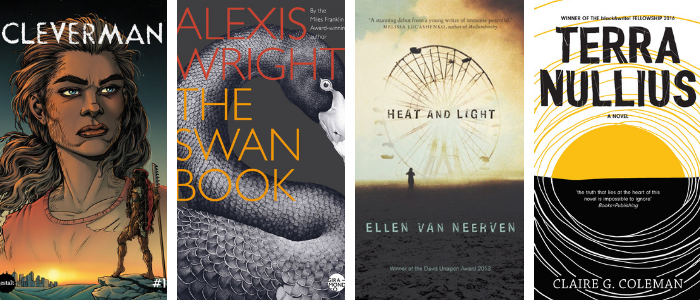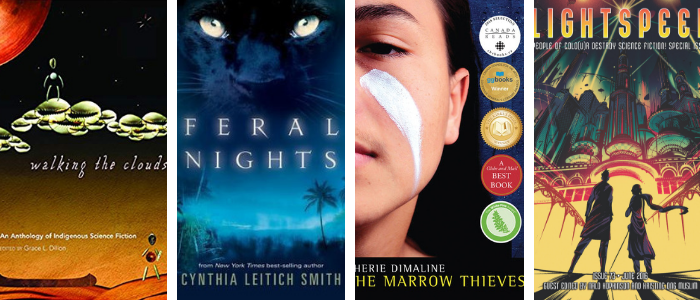AustLit
-
On the Walker Books website, you will find:
- a set of Teachers’ Notes for Book 1 of The Tribe series, The Interrogation of Ashala Wolf.
- A detailed Education Resource Booklet for the entire series, The Tribe.
Alternatively, as it is unlikely that the whole series would be studied formally in a classroom, teachers may wish to set up a Literature Circle for students to explore their responses to and understandings of the series. If you are interested in knowing how to implement a Literature Circle, go here, here, and here.
-
Activity Six: Narration — Who Sees? Who Speaks?
The choice of narrator can have a big impact on how readers are invited to think about the world constructed by the author and the events that happen to the characters. For example, if a story is told in first person from the perspective of the protagonist, his or her actions are likely to be accepted by the reader, i.e. readers are positioned to side with the protagonist by ‘inhabiting’ their perspective. On the other hand, a story written in third person and narrated by someone external to the story positions readers as more detached observers.
So, across The Tribe series, ask students to consider:
- Who sees? In other words, is the narrator external to the story, internal to the story, or omniscient (knows everything that is happening and thought).
- Who speaks? In other words, is the story in first, second or third person? Is the narrator reliable (i.e. can be trusted) or unreliable (i.e. might not be trustworthy)?
There is a change in narration across Book 1, 2 and 3. Have students:
- identify the changes that occur, specifically Book 1 has one, first person narrator (Ashala); Book 2 is narrated by Ashala, and - through the memory stone - Ashala as Ember; Book 3 is narrated by two characters (Ashala and Georgie). Note that all three narrators are female characters in the series.
- and explain their significance (readers are positioned slightly differently by each shift in narration; the different voices provide different perspectives on the action and issues).
The choices made by Ambelin Kwaymullina are discussed the Author’s Note to Book 3 and would provide interesting, further reading for teachers and students.
-
Activity Seven: Context — The Storyworld
Encourage students to explore the question: In what sort of world does Ashala live? As the story progresses and Ashala moves through this world, students should identify clues that enable readers to build a picture of the storyworld created by Kwaymullina:
- the (fictional) history of Ashala’s world.
- political structure, e.g., Who has the power? Who does not have power? How are decisions made in this world (at various levels, including by The Tribe)?
- social context, e.g., the social hierarchy, socially acceptable and unacceptable behaviour.
- the world’s culture, e.g., arts, religion, entertainment, education.
- physical setting, e.g., the geography and appearance of the world.
-
Activity Eight: Kwaymullina’s Worldview and an Indigenous Perspective
In the Author’s Note for Book 2, The Disappearance of Ember Crow, Kwaymullina states explicitly that:
the Tribe series is a work of Indigenous futurism, a form of storytelling in which Indigenous authors use our cultures, knowledge, and experiences to confront colonial stereotypes and imagine Indigenous futures. So to understand the nature of humanity in the world of the Tribe, I needed to look at it from an Indigenous perspective.
Students should be encouraged to read the full Author Notes at the end of both Books 2 and 3 where this Indigenous perspective is elaborated on. Students can also view Kim Wilkins’s interview with Kwaymullina, especially from 4 minutes 12 seconds onwards.
Then, as students read one or more of the novels, they should:
- identify specific aspects of the series that have been influenced by Indigenous perspectives.
- consider how these perspectives influence the way that Kwaymullina uses and innovates on the fantasy genre. For example, ask students to brainstorm the typical characters that occur in fantasy. They can then compare their list to the TV Trope’s list – see Archetypal Character. Once students understand these common archetypes, they can be asked to search for any that might be evident across The Tribe series – and especially any archetypes that are challenged or subverted, e.g., they could consider if Ashala is the ‘typical’ hero as portrayed in many Western fantasy novels.
-
Indigenous futurism from Australian authors: Cleverman (graphic novel), The Swan Book (Alexis Wright), Heat and Light (Ellen van Neerven), and Terra Nullius (Claire G. Coleman).
-
Indigenous futurism from international authors: Walking the Clouds (ed. Grace Dillon), Feral Nights (Cynthia Leitich Smith), The Marrow Thieves (Cherie Dimaline), and Lightspeed magazine's 'People of Colour Destroy Science Fiction' issue.
-
Activity Nine: Construction and Development of Characters
Characters are not real people: they are created by authors out of the building blocks of language. Moreover, they are created in such a way to encourage readers’ like or dislike. While students should be encouraged to read for pleasure and immerse themselves in the world of the text (including its characters), there is also a need for students to learn how to analyse characters more formally and systematically.
Therefore, students working in small groups can be assigned a key character (e.g., Ashala, Neville, Connor, Hoffman, Georgie, etc.) to analyse using the table below. This table can be repeated at various points in the series to track potential changes in the way the character is portrayed.
Name of Character:
Guiding Questions Evidence from the text (including quotations), with page references What does the character think and feel? What does the character say and how? What do other characters say? How do they react to the character? What does the narrator say? After completing the table, students can consider questions such as the following:
- Does the author want readers to like or dislike the character – or even feel ambivalent, i.e., neither like nor dislike?
- What words might you use to describe the character, e.g. happy/unhappy, special/normal/abnormal, trustworthy/untrustworthy, honest/dishonest and so forth?
- Does the character change over the course of the novel? Is this for the better or worse? How does any change compare to the way other characters in the story either change or don’t change?
In addition, students can consider:
- Who are the protagonist and antagonist?
- Who are their respective allies?
- Are any contrasting characters evident?
You might be interested in...






